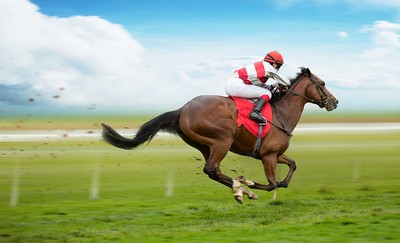 The Grand National is often referred to as the ‘World’s Greatest Steeplechase’, with horses taking on the Aintree Racecourse event in a bid to cement their place in history. It is one of the toughest courses in the United Kingdom, which makes the achievements of horses like Red Rum and Tiger Roll, both of whom won it more than once, all the more impressive. It is, in many ways, a brutal course, which obviously leads many animal rights protestors to question its very existence, with the course doing what it can to make it safer year-on-year.
The Grand National is often referred to as the ‘World’s Greatest Steeplechase’, with horses taking on the Aintree Racecourse event in a bid to cement their place in history. It is one of the toughest courses in the United Kingdom, which makes the achievements of horses like Red Rum and Tiger Roll, both of whom won it more than once, all the more impressive. It is, in many ways, a brutal course, which obviously leads many animal rights protestors to question its very existence, with the course doing what it can to make it safer year-on-year.
Part of the difficulty of the event comes in the number of horses that take part, with the maximum field of 40 horses often reached. The other challenge comes from the fences, which are amongst the hardest to jump in horse racing. In fact, many of the fences are well-known enough to boast their own names. The horses jump most of them twice: once on the first circuit and then again on the second. The question is, which of the circuits poses the greatest challenge to the horses as they make their way around the racecourse?
Quick Answer: Which Circuit of the Grand National Has More Fallers?
Between 1984 and 2023, there were 311 fallers in the Grand National. Of those, 229 or 73.6% were on the first circuit whilst 82 or 26.4% were on the second circuit.
In terms of individual jumps, the first fence on the first circuit had the most fallers with 60 or 19.3%, again between 1984 and 2023.
When looking at specific fences across the entire two circuit race, fence number 6 and 22, which is Becher’s Brook, has claimed the most fallers with 67 in total in this same time frame, 40 on the first circuit and 27 on the second.
Taking On The Fences The First Time Around
 When the horses come under starter’s orders in the Grand National, there are usually 40 runners vying for position to get underway in the race. It is little wonder, therefore, that the very first fence that they jump is such a difficult one for them to get over smoothly and safely. It isn’t just that the fence is a challenging one to get over, but also that the jockeys are having to hustle for space against competitors whilst also lining their horses up to make the jump successfully. That combination can be too difficult for some to master.
When the horses come under starter’s orders in the Grand National, there are usually 40 runners vying for position to get underway in the race. It is little wonder, therefore, that the very first fence that they jump is such a difficult one for them to get over smoothly and safely. It isn’t just that the fence is a challenging one to get over, but also that the jockeys are having to hustle for space against competitors whilst also lining their horses up to make the jump successfully. That combination can be too difficult for some to master.
There are 30 jumps during the Grand National, but only 16 fences. As a result, the first 14 are jumped twice, with two fences being missed out on the second circuit. The fences that are missed out on the second go around are fence 15, which is also known as The Chair, and fence 16, the water jump. That they are missed out on the second time around is relevant for the next section, whereas right now we will think about them because they are jumped on the first circuit, so the number of horses that fall at them are relevant.
Between the running in 1984 and the one in 2023, 311 horses have fallen. Though that obviously isn’t inclusive of every race that has ever taken place in the Aintree event, it is more than enough data to give us a sense of how horses tend to fair in the modern version of the famous race. It is also enough data to conclude whether it is the first or the second circuit that is the most difficult for them to navigate, with the first being when there is a higher percentage of horses jockeying for position to maker their jump of each fence.
Here is a look at the data surrounding the number of horses that fall at each of the fences during the first circuit of the Aintree course:
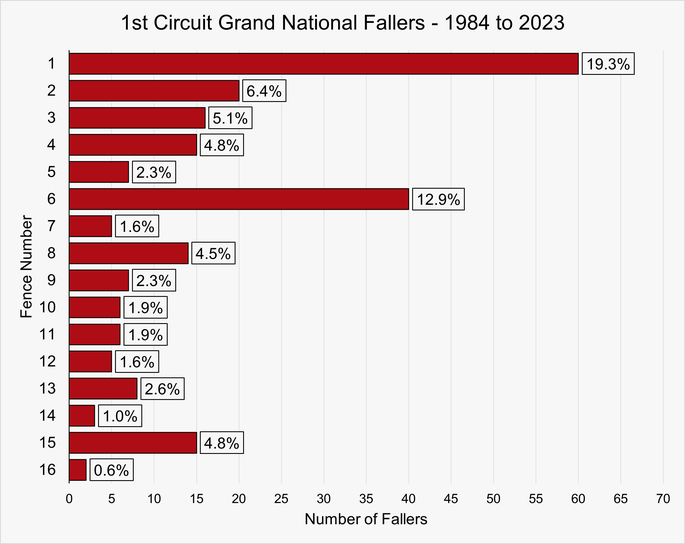
It is clear from the evidence that the first fence is easily the toughest for the horses to navigate. That sense of needing to get enough room to get the timing of the jump right is there to see in the numbers, to say nothing of the fact that the horses are going into it ‘cold’, rather than having gained some rhythm from previous jumps.
Taking On The Fences The Second Time Around
 There is no question, looking at the data, that the first circuit poses a real problem to the horses due to the sheer number of horses that are all vying to get over the fences at roughly the same time. If you watch it on the television or are lucky enough to be at the racecourse, you can see the madness of all of the horses heading to the first fence alongside each other and trying to get over it successfully. The limbs of the horses and colours of the jockeys all seem to blend into one as the horses take on the obstacle.
There is no question, looking at the data, that the first circuit poses a real problem to the horses due to the sheer number of horses that are all vying to get over the fences at roughly the same time. If you watch it on the television or are lucky enough to be at the racecourse, you can see the madness of all of the horses heading to the first fence alongside each other and trying to get over it successfully. The limbs of the horses and colours of the jockeys all seem to blend into one as the horses take on the obstacle.
Once the horses have reached the 16th fence, the field tends to be a little bit more strung out. The result is that there isn’t as much of a battle for space when each of the fences comes around, meaning that the horses are able to more readily attack the fence at their own pace. The flip side of this, though, is that tiredness is starting to creep into the horses as they make their way towards each fence, with the slog-like nature of the course being one that makes it a genuinely tough challenge for the competitors to cope with.
Here, then, is a look at the data for the horses on the first fourteen fences the second time around, minus fences 15 and 16 on account of the fact that they aren’t jumped:
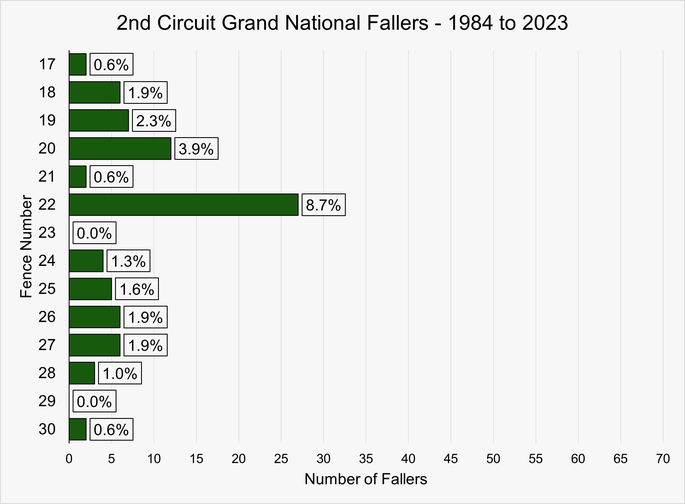
Whilst we can clearly see that horses still fall on the second circuit, the numbers are down compared to the first circuit. Though tiredness is an important factor, it doesn’t appear to be as crucial to what happens to the horses on the second circuit as the number of them running matters in the first.
Which Fences Are The Toughest?
In order to get a better sense of whether volume of competing horses or tiredness is the most crucial factor in the Grand National, it is worth having a look at the difference in the number of fallers between the first and second circuit.
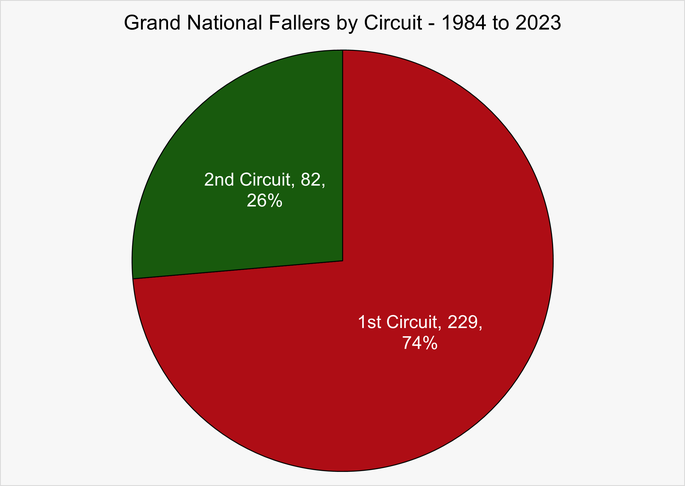
We can see there is a clear difference between the number of runners that fall on the first circuit in comparison to the second circuit.
We can also look more closely at the total numbers of fallers at each individual fence. Here is a side-by-side comparison to help up better understand that.
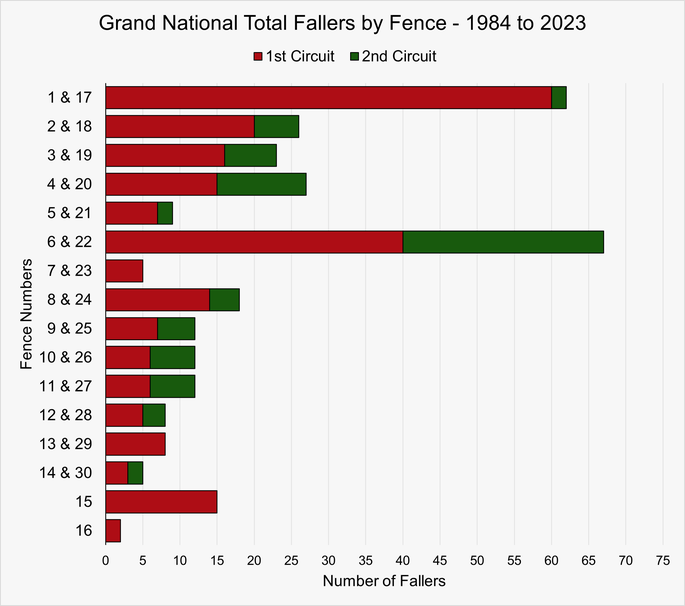
There is a spell of the 10/26th and 11th/27th fences where the number of fallers has been the same on both circuits across the timespan that we’re looking at, suggesting that the horses have got into their rhythm by that point of each circuit. You can even add in 9th/25th and 12th/28th, given that the difference in the number of fallers between the first and second circuit is just two for both. That eight fell at the 13th and none when it was jumped the second time suggests that tiredness isn’t as much of a factor as you might have thought.
Whichever way you look at it, it certainly appears as though the number of horses running in the race is more of a deciding factor than tiredness when it comes to horses falling in the Grand National. Of course, we also need to remember that horses will have more rhythm in their legs by the second circuit, which will play a part in helping them to get over the fences more successfully. You can also see from the increased number of falls at the 6th/22nd fence that the difficulty of the obstacle is also important when it comes to horses falling.
That fence is Becher’s Brook, which has accounted for 67 of the fallen horses between 1984 and 2023. Though the first fence is the toughest on the first circuit, resulting in 60 falls during the period that we’re looking at, only two fell at it on the second circuit. In other words, five more horses have fallen at Becher’s Brook than at the 1st/17th fence, pointing to the nature of just how challenging a fence it is for the horses to get over regardless of the circuit that they’re jumping it in.
Ultimately, it is likely to be the case that the Grand National is just a very difficult course to jump round. That would explain why the number of horses struggling over the fences when there are a large number of other horses jumping with them is a factor, as well as why horses continue to fall on the second circuit even after the field has begun to thin out. It would also explain why some fences, such as Becher’s Brook, are just significantly more difficult to navigate than others, irrespective of the circuit that is taking place.
